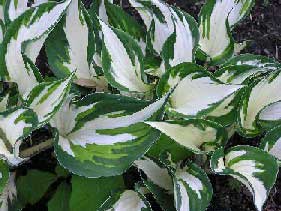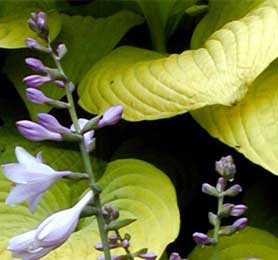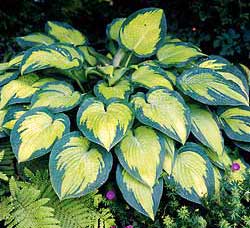Growing Hosta
Hosta are not all alike in the way they respond to our Cincinnati growing environment. They are not even alike in the way they grow in just one garden. But be forewarned - after you have a certain number of them growing well in your yard, they become addictive. You will come to our nursery meeting or plant auction and find yourself helpless to not buy some more.
 Hosta are relatively easy to grow. Although they are initially not a cheap yard plant, they are quite economical over time. They are perennials that tolerant shade very well and are mainly grown for their foliage. There are greens, blues, golds, center-variegated, edge-variegated and streaked. They have a variety of shapes and surface textures. Many of them do quite well in sun and many of them also have nice flowers. With a few different varieties, you can have one in bloom from mid June till October. They come in all sizes from giants 8 feet across to minis of only several inches. It gets difficult after a while to decide which ones you like the best.
Hosta are relatively easy to grow. Although they are initially not a cheap yard plant, they are quite economical over time. They are perennials that tolerant shade very well and are mainly grown for their foliage. There are greens, blues, golds, center-variegated, edge-variegated and streaked. They have a variety of shapes and surface textures. Many of them do quite well in sun and many of them also have nice flowers. With a few different varieties, you can have one in bloom from mid June till October. They come in all sizes from giants 8 feet across to minis of only several inches. It gets difficult after a while to decide which ones you like the best.
Hosta are native to China, Japan and Korea and have been grown in the USA for more than 150 years. Experts differ on the number of hosta species; there may be as many as 45. Today there are over 4000 registered cultivars available to home gardeners as a result of hybridizing and tissue culture techniques. Anyone may register a Hosta cultivar. If you get lucky, one may even mutate in your yard and you can add it to the list.
 Hosta make excellent potted plants. Some grow like weeds and some are very slow to develop. It takes about 6 years for them to reach their maximum size. They love lots of water, about an inch of rain per week, delivered twice a week. We normally get only about a half-inch with periods of drought so regular plentiful watering is strongly advised. They don’t like our hot summer days. Slugs love eating holes in tender leafed hosta. They are sometimes called deer salad. You will be amazed at some of the efforts by our members to protect their hosta from these pests. They can tell you what does and doesn’t work for them.
Hosta make excellent potted plants. Some grow like weeds and some are very slow to develop. It takes about 6 years for them to reach their maximum size. They love lots of water, about an inch of rain per week, delivered twice a week. We normally get only about a half-inch with periods of drought so regular plentiful watering is strongly advised. They don’t like our hot summer days. Slugs love eating holes in tender leafed hosta. They are sometimes called deer salad. You will be amazed at some of the efforts by our members to protect their hosta from these pests. They can tell you what does and doesn’t work for them.
 Hosta expert Bob Solberg (click here for more tips from Bob) recommends leaf fertilizing using Miracle-Gro Tomato Plant Food (contains magnesium) early in the year every two weeks when they are growing most rapidly. Manure is a good source for nutrients and delayed release fertilizers will supply nitrogen for all the summer. Sun exposure depends on the variety. A good rule of thumb is several hours of morning or late evening sun is desirable for many of them. The less green or blue the leaf, the more sun is actually needed by the plant to grow well and look its best. Click here for more culture information from the American Hosta Society.
Hosta expert Bob Solberg (click here for more tips from Bob) recommends leaf fertilizing using Miracle-Gro Tomato Plant Food (contains magnesium) early in the year every two weeks when they are growing most rapidly. Manure is a good source for nutrients and delayed release fertilizers will supply nitrogen for all the summer. Sun exposure depends on the variety. A good rule of thumb is several hours of morning or late evening sun is desirable for many of them. The less green or blue the leaf, the more sun is actually needed by the plant to grow well and look its best. Click here for more culture information from the American Hosta Society.